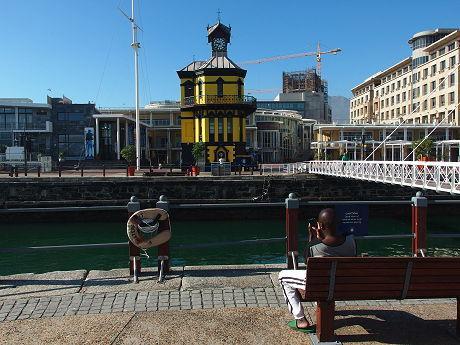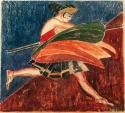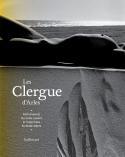Art Of The Day Weekly
#356 - from 18 September 2014 to 24 September 2014

The Waterfront in Cape Town. In the forefront, the Clock Tower, painted in yellow to celebrate the Capital of Design). Behind, the grain silos that will become the MOCAA (Museum of Contemporary Art Africa). Photo R. Pic
IN THE AIR
Letter from Cape Town
A few years after the World Cup in 2010, the spot light is once again on South Africa. The event is not as glorious, it is the verdict of the Pistorius trial. We know the other major attractions: safaris, rugby, Mandela, among others. However, we should remember the country also has an array of cultural assets. In this beginning of the Southern spring Cape Town is the first city in Africa to receive the title of “world capital of design”, awarded every two years since Torino in 2008. Nearly 500 events have been programmed, including exhibitions, conferences or themed promenades. Aside from the buildings that have made the headlines such as the Waterfront complex in 1992 or the Green Point Stadium in 2010, a huge museum of contemporary art – the MOCAA -is to open in the former silos of the port, redesigned by Thomas Heatherwick. A sort of Tate Modern of the southern hemisphere. To enjoy a glimpse on how these former industrial buildings are being used, one must visit the current most dynamic district, where a former cookie factory (The Biscuit Mill), a former foundry (The Foundry) and various Art deco warehouses are brought in for a second life, combining well-renowned chefs (Luke Dale-Roberts), ceramic artists and organic farmers. The name is easy to remember and rings like a manifesto: Woodstock.
EXHIBITIONS

Gilded bronze figure of Sakyamuni, the historical Buddha, Nanjing, China, Ming Dynasty, Yongle mark and period, 1403-1424 (detail)
The Ming, a dynasty that changed China
LONDON – Certain Anglo-Saxon commentators havecalled it, maybe with reason, the ultimate possibility of contemplating a general retrospective of the Ming culture. Indeed the Chinese government has committed to no longer allowing as many works of art –of which some have only been discovered recently -to travel together. The golden age it presents is very precise, as it concerns the first half of the 15th century during which the new masters, while setting up the country’s capital in Beijing, witness an artistic development equal to the one that has taken over in Renaissance Italy at the same time: porcelain, stone sculpture, lacquer, painting on scrolls, gilded bronze, jewelry…
• Ming, 50 years that changed China at the British Museum, from 18 September 2014 to 5 January 2015.

Claude Monet, Impression, soleil levant, 1872, oil on canvas, 50x65 cm, Musée Marmottan Monet, Paris © Christian Baraja, former Collection Ernest Hoschedé - former Collection Georges de Bellio.
Only an impression?
PARIS – The name is known the world over, but who really knows where it started? It was a painting by Monet, kept at the Marmottan museum that helped baptize –in a non-flattering way- the Impressionist movement. The Impression, soleil levant (Impression, rising sun) played such a seminal role that it deserved to be analyzed inside out. Art historians, genealogists and meteorologists (who remembers it was called Impression, soleil couchant, i.e. Impression, rising sun, until 1865?) contributed in giving clues about the painting, from its conception (1872 or 1873?) to the moment it was hung in the museum, including the various transactions. In 1878 the painting was sold for 210 francs: needless to say its value has somewhat increased since then.
• Impression, soleil levant, at the musée Marmottan Monet, from 18 September 2014 to 18 January 2015
The avant-garde in Russia
PARIS - The name is in all the modern art manuals: industrialist Shchukin was one of the collectors with the greatest vision at the beginning of the 20th century, together with his alter ego Morozov, and accumulated works by Matisse and Picasso. Today, one of the family branches has taken over the task and they exhibit in their Parisian gallery a selection of the Russian avant-garde– Exter, Larionov, Gontcharova – of which some works have been rarely shown to the public.
• Maîtres russes modernes at the galerie Shchukin, from 11 September to 2 November 2014.
Miró, the other Spanish giant
VIENNA – Together with Picasso and Dalí, he makes up the greatest Spanish trilogy of the 20th century. Joan Miró, the most discreet of the three, continues to be the object of retrospectives. Following that of the centre Pompidou, here is one at the Albertina. The museum tries, with some one hundred works, to define the artist’s poetic dimension.
• Joan Miró, from Earth to Sky, at the Albertina, from 11 September 2014 to 11 January 2015.
Picasso, a modern artist among others
FLORENCE – He was certainly an engine in the avant-garde. But, as we can see in the aforementioned Miró exhibition, Picasso was not the only Spanish artist to serve that cause. His universal fame clouded out a number of his contemporaries who deserved better than that, such as sculptor Julio González or his exact contemporary artist Maria Blanchard. She was born in 1881 but died much before Picasso, in 1932, and also spent a good part of her career in Paris. The Palazzo Strozzi tries to put the Spanish talents into perspective.
• Picasso e la modernità spagnola at Palazzo Strozzi, from 25 September 2014 to 20 January 2015.
BOOKS
Clergue, a giant of photography
What we most know of De Clergue’s work are the beautiful nudes in waves, which consolidated his reputation in the world. While he just celebrated his 80th birthday, the musée Réattu celebrates this native son. He is a lover of the Camargue region which he photographed from every angle, from the gypsies to the reeds blowing in the wind. He was the friend of Picasso, having approached him once directly when he was not even twenty years old, as the former was leaving a bullfight. And he is the relentless organizer, who together with his friends Rouquette, Tournier (and others), founded the famous Rencontres photographiques d’Arles in 1969, which will soon celebrate their 50 years of existence. The work shows a part of the important donation which De Clergue just offered the musée Réattu, that is his own icons and a few others due to the forerunners he befriended and admired, from Weston to Mapplethorpe. A sort of spiritual testament for a pioneer: we are indeed very indebted to him for the recognition photography has as an art form in its own right.
• Les Clergue d’Arles, collective, Gallimard, 2014, 200 p., €35.
OPENINGS OF THE WEEK

APOCALYPSE – 10 LIVES
24 Septembre 2014 - PARIS - Centre culturel canadien
Centered on the First World War, a work that blends comics, historical archives and animation


